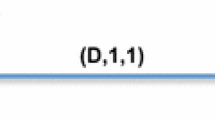Introduction
Evacuation is one of the most perilous, pernicious, and persistent problems faced by humanity. Hurricanes, fires, earthquakes, explosions and other natural and man-made disasters happen on almost a daily basis throughout the world. How can we safely evacuate a collection of occupants within an affected region or facility is the fundamental problem faced in evacuation.
Access this chapter
Tax calculation will be finalised at checkout
Purchases are for personal use only
Similar content being viewed by others
References
Bakuli DL, MacGregor Smith J (1996) Resource Allocation in state-dependent emergency evacuatin networks. Eur J Oper Res 89:543–555
Berlin GN (1982) A simulation model for assessing building firesafety. Fire Technol 18(1):66–76
Chalmet LG, Francis RL, Saunders PB (1982) Network models for building evacuation. Manag Sci 28(1):86–105
Cheah J (1990) State dependent queueing models. Masters Thesis, Department of Industrial Engineering and Operations Research, University of Massachusetts, Amherst
Cheah J, MacGregor Smith J (1994) Generalized M/G/c/c state dependent queueing models and pedestrian traffic flows. Queueing Syst Appl 15:365–386
Cruz FRB, MacGregor Smith J, Medeiros RO (2005) An M/G/c/c State Dependent Network Simulation Model. Comput Oper Res 32 (4):919–941
Cruz FRB, MacGregor Smith J, Queiroz DC (2005) Service and Capacity Allocation in M/G/c/c State Dependent Queueing Networks. Comput Oper Res 32(4):919–941
Cruz FRB, MacGregor Smith J (2007) Approximate Analysis of M/G/c/c State Dependent Queueing Networks. Comput Oper Res 34:2332–2344
Francis RL, Chalmet LG (1980) Network models for building evacuation: a prototype primer. Unpublished Paper, Department of Industrial and Systems Engineering, University of Florida, Gainesville
Fruin JJ (1971) Pedestrian Planning and Design. Metropolitan Association of Urban Designers and Environmental Planners, New York
Hahn, Peter, MacGregor Smith J, Yi-Rong Zhu (2007) The Multi-Story Assignment Problem, in review
Jain R, MacGregor Smith J (1997) Modeling Vehicular Traffic Flow using M/G/c/c State Dependent Queueing Models. Transp Sci 31(4):324–336
Karbowicz CJ, MacGregor Smith J (1984) A k-shortest path routing heuristic for stochastic evacuation networks. Eng Optim 7:253–280
Kelly FP (1979) Reversibility and Stochastic Networks. Wiley, Chicester
Kostreva M, Wiecek MW (1993) Time Dependency in Multiple Objective Dynamic Programming. J Math Anal Appl 173:289–307
MacGregor Smith J, Rouse WB (1979) Application of Queueing Network Models to Optimization of Resource Allocation within Libraries. JASIS 30(5):250–263
MacGregor Smith J (1981) The Use of Queueing Networks and Mixed Integer Programming to Optimally Allocate Resources within a Library Layout. JASIS 32(1):33–42
MacGregor Smith J, Towsley D (1981) The Use of Queueing Networks in the Evaluation of Egress from Buildings. Environ Plan B 8:125–139
MacGregor Smith J (1982) An Analytical Queueing Network Computer Program for the Optimal Egress Problem. Fire Technol 18(1):18–37
MacGregor Smith J (1982) Queueing Networks and Facility Planning. Build Environ 17(1):33–45
MacGregor Smith J (1987) QNET-C: an interactive graphics computer program for evacuation planning. In: Newkirk R (ed) Proceeding of the Society for Computer Simulation Emergency Planning Session, SCS Multi-conference, Orlando. pp 19–24
MacGregor Smith J (1991) State Dependent Queueing Models in Emergency Evacuation Networks. Transp Sci: Part B 25B(6):373–389
Stahl FI (1982) BFIRES-II: A Behavior Based Computer Simulation of Emergency Egress during Fires. Fire Technol 18(1):49–65
Stepanov A (2008) An Integrated Methodology for Optimal Egress Route Assignments during Population Evacuation under an Evolving Emergency Event. PhD Dissertaion. Department of Mechanical and Industrial Engineering, University of Massachusetts, Amherst
Talebi K, MacGregor Smith J (1984) Stochastic network evacuation models. Comput Oper Res 12(6):559–577
Tregenza P (1976) The Design of Interior Circulation. Van Norstand Reinhold Company, New York
Watts JM (1986) Computer models for evacuation analysis. Paper presented at the SFPE Symposium: Quantitative Methods for Life Safety Analysis College Park Maryland. Available from the Fire Safety Institute, Middlebury
Wen Y, MacGregor Smith J (2007) Stochastic Flow Analysis of the Evacuation of Multi-Story Facilities. in review
Wen Y, MacGregor Smith J (2007) Stairwell Width Optimizationi in the Evacuation of Multi-Story Facilities. in review
Wen Y, MacGregor Smith J (2007) On the Equi-Area Partitioning Problem for Rectilinear Simple Polygons. in review
Wen Y (2007) Design, Evaluation and Optimization of the Evacuation Problem of Multi-Story Facilities. PhD Dissertaion. Department of Mechanical and Industrial Engineering, University of Massachusetts, Amherst
Woodside CM, Hunt RE (1977) Medical Facilities Planning Using General Queueing Network Analysis. IEEE Trans SMC 7(11):793–799
Yuhaski S, MacGregor Smith J (1989) Modeling circulation systems in buildings using state dependent queueing models. Queueing Syst Appl 4:319–338
Author information
Authors and Affiliations
Editor information
Editors and Affiliations
Rights and permissions
Copyright information
© 2008 Springer-Verlag
About this entry
Cite this entry
Smith, J.M. (2008). Evacuation Networks . In: Floudas, C., Pardalos, P. (eds) Encyclopedia of Optimization. Springer, Boston, MA. https://doi.org/10.1007/978-0-387-74759-0_166
Download citation
DOI: https://doi.org/10.1007/978-0-387-74759-0_166
Publisher Name: Springer, Boston, MA
Print ISBN: 978-0-387-74758-3
Online ISBN: 978-0-387-74759-0
eBook Packages: Mathematics and StatisticsReference Module Computer Science and Engineering





